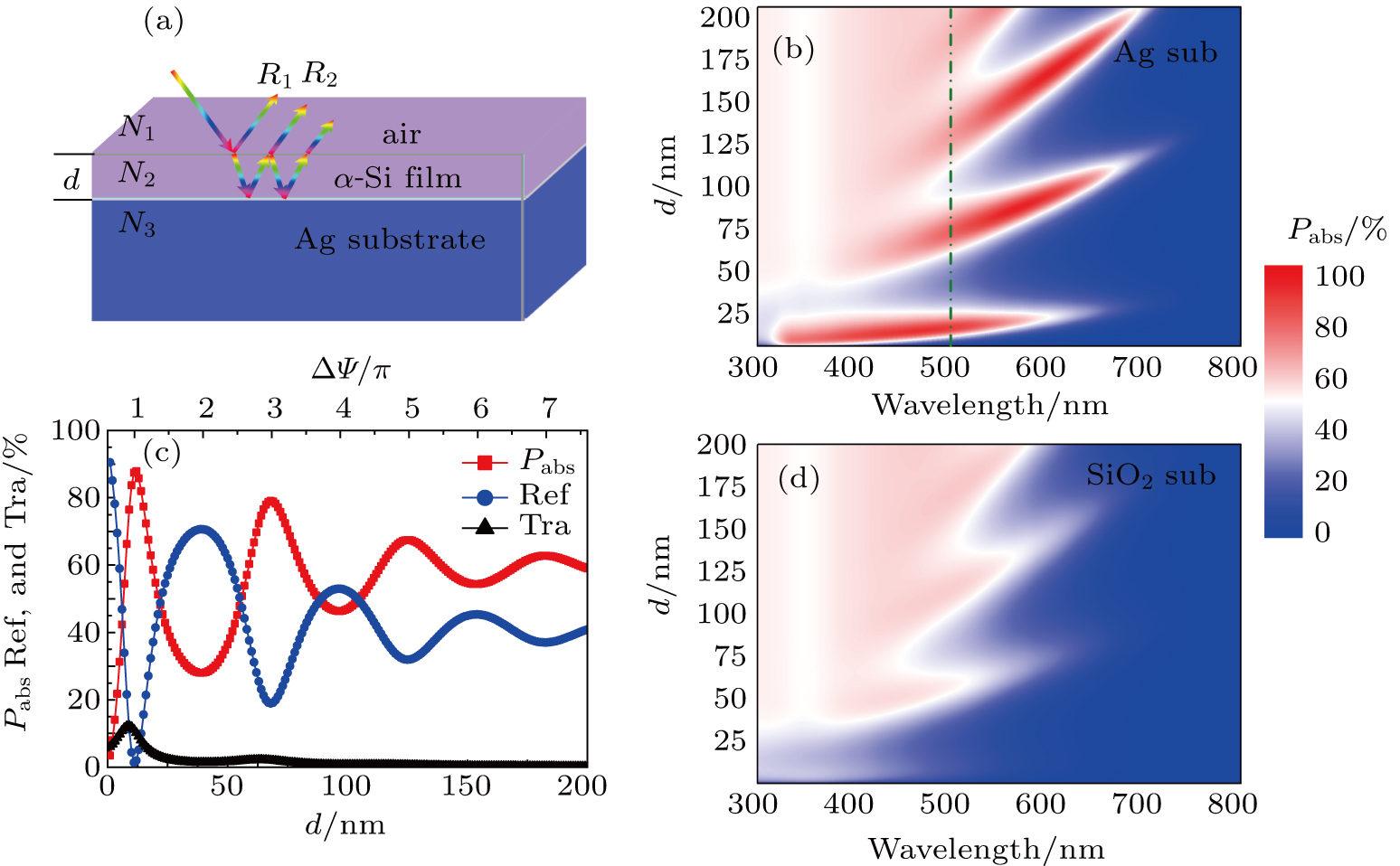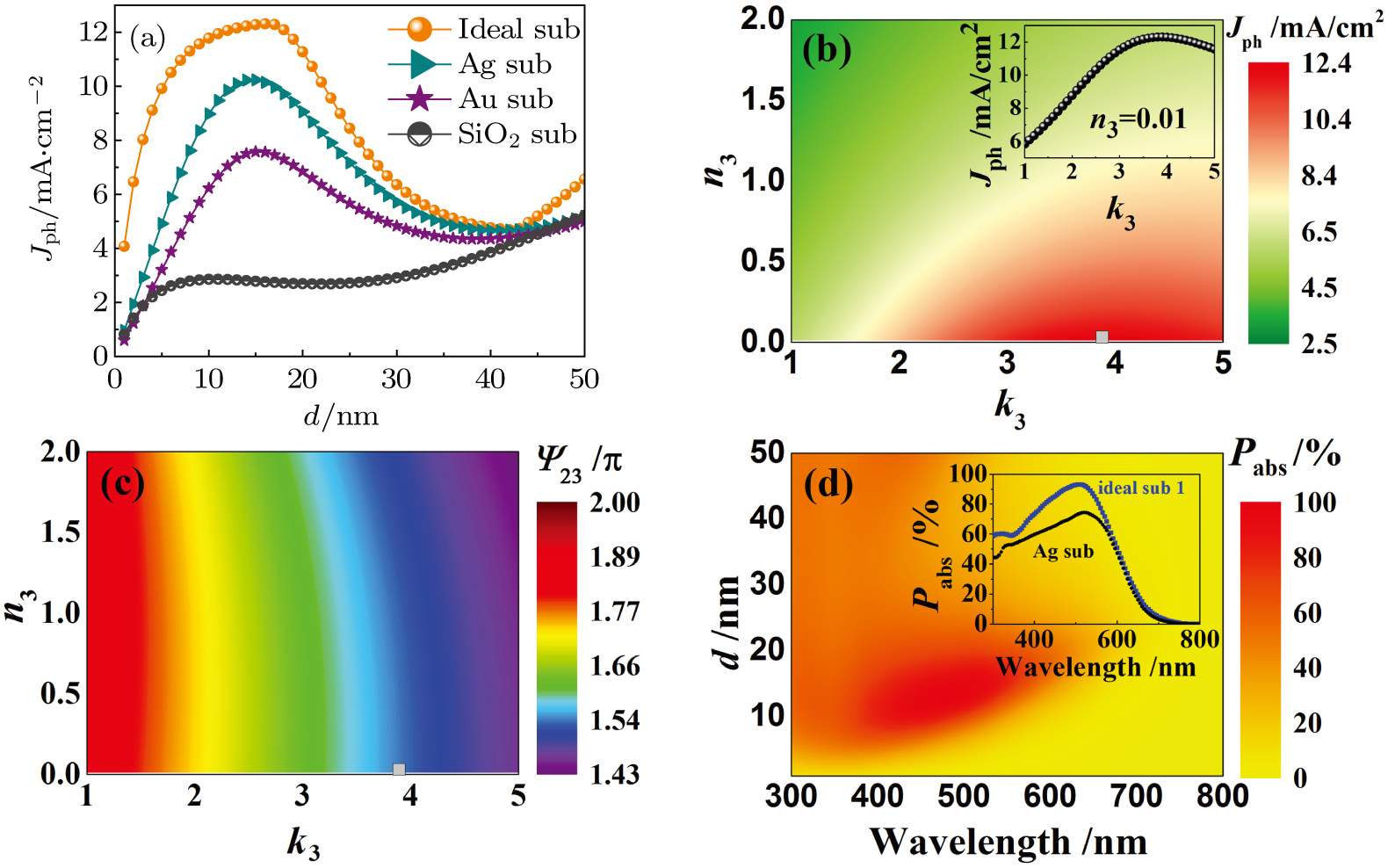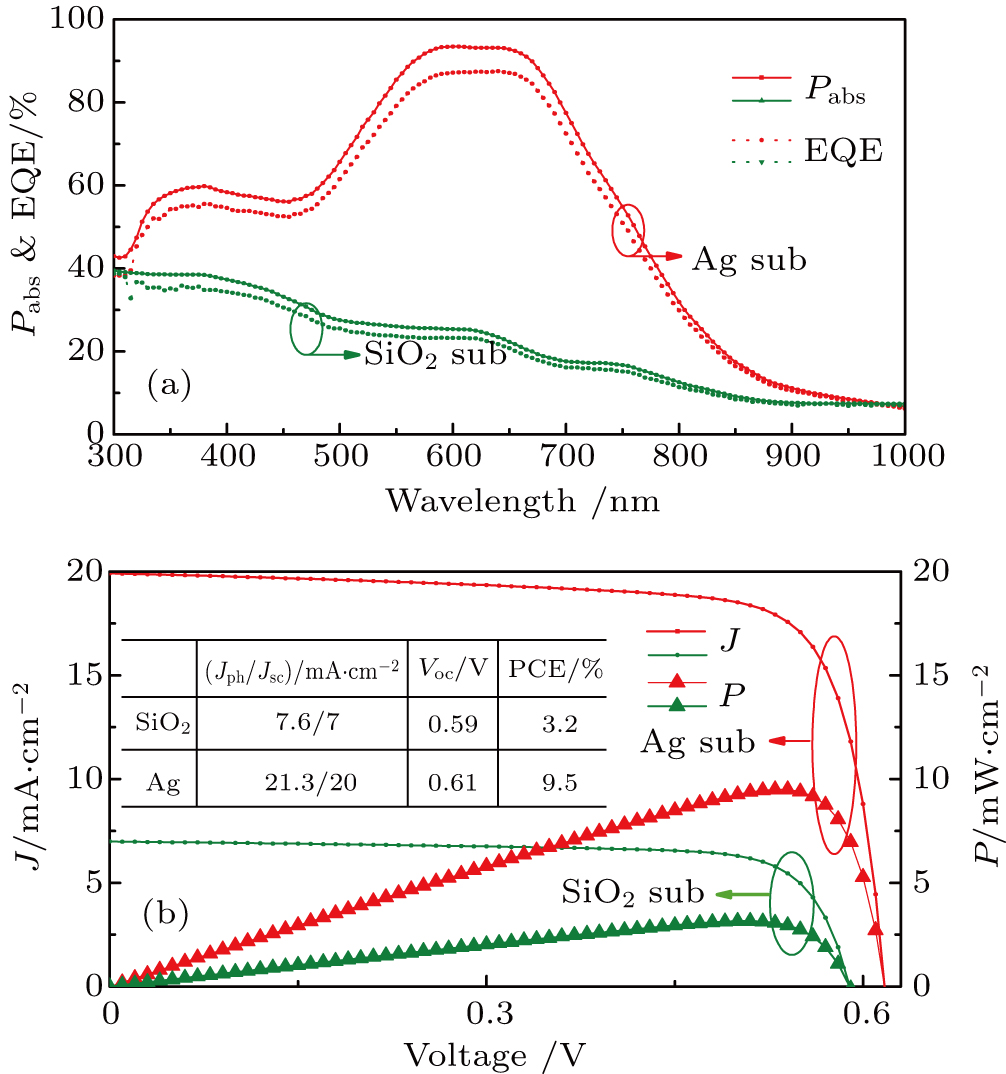† Corresponding author. E-mail:
Project supported by the National Natural Science Foundation of China (Grant Nos. 61675142 and 61875143), the Natural Science Foundation of Jiangsu Province, China (Grant No. BK20140359), the Natural Science Research Project of the Higher Educational Institutions of Jiangsu Province, China (Grant No. 17KJA480004), the Postgraduate Research & Practice Innovation Program of Jiangsu Province, China (Grant No. KYCX17 2027), and the Priority Academic Program Development of the Higher Educational Institutions of Jiangsu Province, China.
Ultrathin optical interference in a system composed of absorbing material and metal reflector has attracted extensive attention due to its potential application in realizing highly efficient optical absorption by using extremely thin semiconductor material. In this paper, we study the physics behind the high absorption of ultrathin film from the viewpoint of destructive interference and admittance matching, particularly addressing the phase evolution by light propagation and interface reflection. The physical manipulations of the ultrathin interference effect by controlling the substrate material and semiconductor material/thickness are examined. We introduce typical two-dimensional materials — i.e., MoS2 and WSe2 — as the absorbing layer with thickness below 10 nm, which exhibits ∼ 90% absorption in a large range of incident angle (0° ∼ 70°). According to the ultrathin interference mechanism, we propose the ultrathin (< 20 nm) MoS2/WSe2 heterojunction for photovoltaic application and carefully examine the detailed optoelectronic responses by coupled multiphysics simulation. By comparing the same cells on SiO2 substrate, both the short-circuit current density (up to 20 mA/cm2) and the photoelectric conversion efficiency (up to 9.5%) are found to be increased by ∼ 200%.
Highly efficient optical absorption plays a fundamental role in a broad range of optoelectronic applications, including photoelectric conversion (e.g., photodetection and photovoltaics),[1,2] photochemical cells,[3,4] light emission,[5,6] sensing,[7] etc. A photon-harvesting device without a good absorption can hardly obtain a high performance, no matter how the electrical conversion is optimized. Unfortunately, highly absorbing materials are always highly impedance-mismatched with air, leading to high reflection by the device surface.[8] Strengthened optical absorption can be achieved by employing the photonic designs. The most conventional strategy is to introduce single layer or multi-layer antireflection (AR) coatings composed of lossless dielectrics.[9] However, the AR layers need a quarter-wavelength in thickness, which hinders the miniaturizing of the optoelectronic devices (especially for infrared or far-infrared devices). Recently, with the rapid progress of nanofabrication technologies, the deep-subwavelength systems with broadband and high absorption (e.g., those that are based on plasmonics or metamaterials) have been extensively studied and demonstrated.[10–14] Nevertheless, such systems largely rely on the precisely nanopatterning one or several layers, which require costly and complicated fabrication, thus hindering them from being used on a large-scale and lowing their cost in application.
Recently, a simple and ingenious solution based on anti-reflection principle was proposed to realize a broadband, wide-angle, and ultrahigh absorption in the ultrathin film with 10 nm–20 nm in thickness (far less than the quarter-wave thickness).[9,15–18] In the solution, 1) light-absorbing semiconductor replaces the conventional lossless dielectric material and 2) metal is used as back reflector. The special combination of highly absorbing semiconductor and metal reflector can greatly reduce the AR thickness because the reflection phase-shift introduced by the semiconductor/metal interface is significantly increased so that the required phase variation through the semiconductor becomes substantially small, allowing a much smaller thickness of the material. The unique thin-film planar scenario enables an extremely high absorption in the ultrathin semiconductor film. For example, Kats (Park) et al. reported that the 15 (12) nm Ge film on Au (Ag) substrate can absorb over 80% (98%) of light at a wavelength of λ ∼ 670 (625) nm.[9,16] Such a planar system has also various applications, e.g., in ultrathin color coatings,[9] broadband solar energy harvesting,[1,19] ultrathin devices based on van der Waals semiconductors,[15] etc. It has been indicated that the material and dimension of the metal and the semiconductor are critical for the ultrathin system to achieve high optical performance. Moreover, various deep-subwavelength film/metal systems under the same AR condition exhibit very distinguished optical absorbing performances. Therefore, more details of the fundamental optics within the ultrathin devices are required if we wish to better control the light coupling with the materials. In addition, the applications of this new system need to be further explored. For example, for the ultrathin solar cells, it is necessary to combine the superior optical performance with the realistic carrier transport/recombination process so that the complete optoelectronic performance of the device can be evaluated for a better device design.
In this paper, we first investigate the underlying optical mechanism responsible for the high absorption of the ultrathin semiconductor film on metal substrate, particularly addressing the phase evolution with the interface reflection and internal propagation, and also quantifying the phase condition for the destructive interference. The optical performances of the system under various semiconductor materials, semiconductor material thicknesses, and substrate materials are systematically studied. Moreover, an ideal substrate enables the system to possess the better absorption performance of the system than the systems under realistic metal or dielectric substrates. The scheme is further applied to a two-dimensional (2D) system with typical 2D materials, i.e. MoS2 and WSe2, which exhibits nearly perfect absorption and good angular dependence with a material thickness below 10 nm. Finally, we design the ultrathin MoS2/WSe2 heterojunction for photovoltaic application with carefully examining the detailed optoelectronic responses, such as external-quantum efficiency (EQE) and current–voltage (J–V) curve. Compared with the same solar cell on conventional SiO2 substrate, the short-circuit current density (Jsc) and photoelectric conversion efficiency (PCE) are both improved by ∼ 200%. The strong ultrathin-film interference provides the possibility of realizing miniaturized planar systems for high-performance, low-cost, and large-scale optoelectronic applications.
A sketch of the ultrathin multilayer system is shown in Fig.
We first briefly introduce the calculation process for studying the special optical interference in the ultrathin dielectric/metal system. The reflection coefficient and phase shift in the air/film (film/Ag) interface are denoted as r12 (r23) and Ψ12 (Ψ23), respectively, the phase accumulation in the thin film is represented by Ψd, and the phase difference between the direct surface reflection (R1) and the reflected light by film/Ag after a round-trip propagation through the film (R2) is denoted as ΔΨ (without considering the high-order components). The phase change by interface reflection can be calculated by Fresnel formula. Note that the phase relation just considers the first-order propagation wave inside the ultrathin system. Given that the high-order components show dramatically reduced intensity, this treatment can approximate to the actual antireflection condition. Then we utilize TMM to calculate the optical response of the ultrathin system, including absorption (Pabs), reflection (Ref), and transmission (Tra). The admittance of air, film, and substrate are η1, η2, and η3, respectively. Note that the free space admittance (y0) is taken to be the unit of admittance. The unpolarized sunlight absorption is modelled by the average of light absorptions under transverse-electric (TE, s-polarized) and transverse-magnetic (TM, p-polarized) incidence. The equivalent admittance of the whole system is ηz. The admittance difference between air and the system (i.e., η1 and ηz) is denoted as Δη.
Figures
At λ = 500 nm, the α-Si Pabs, Ref, and Tra of the ultrathin α-Si/Ag system versus d are plotted in Fig.
| Table 1. Values of d, ΔΨ, and Δη at M = 0, 1, 2, and 3. . |
Figure
Actually, for such an ultrathin system, the choice of back reflector is critical because it strongly affects the optical interference on the top surface. Moreover, as mentioned in Fig. 
To achieve a high Jph, figure
However, with the α-Si thickness decreasing into nanosize, the defect density of the ultrathin film becomes dramatically high[15] and this seriously limits the photoelectric conversion performance (despite the fact that the optical performance has been optimized significantly). Therefore, it is necessary to replace the conventional semiconductor material by the high-quality 2D materials; for instance, MoS2, WSe2, and other transition metal dichalcogenides layered materials (TMDLM). These 2D materials show many outstanding properties:[22–25] 1) no surface dangling bond, thus reducing the carrier loss caused by surface recombination, 2) strong light-absorbing ability [light is absorbed by the single layer MoS2 (0.65 nm) is approximate to that of 50-nm-thick Si], and 3) reasonable and tunable bandgap by controlling the number of layers. In Fig.
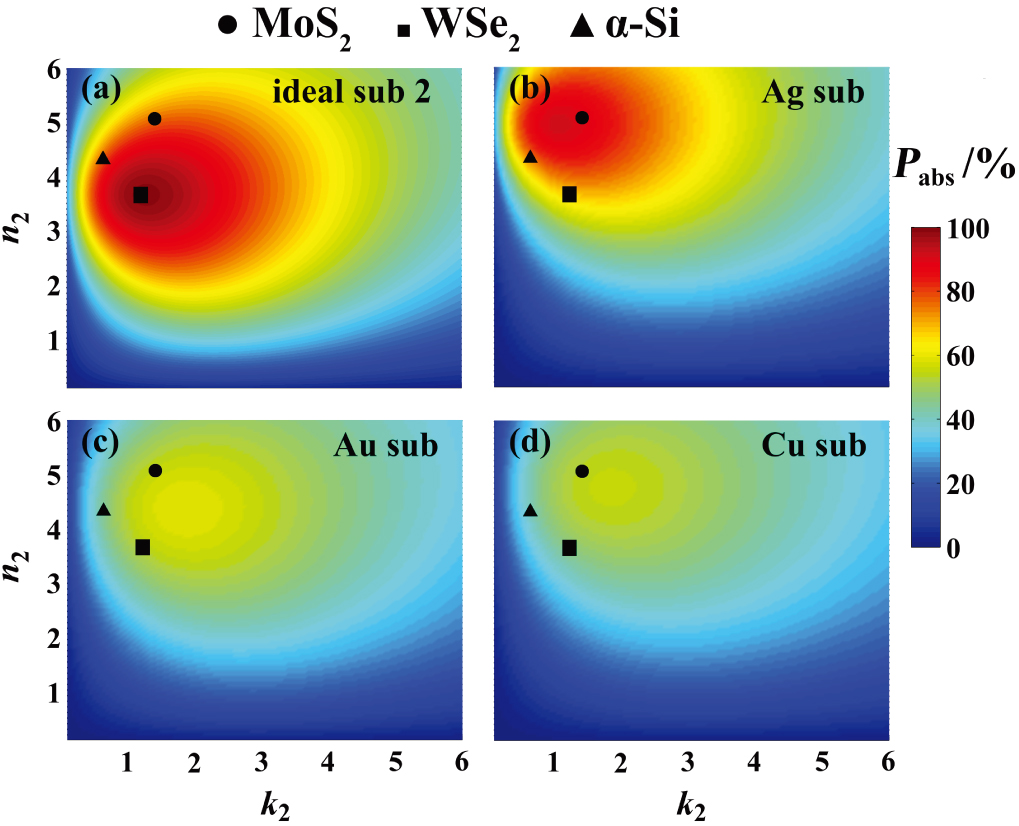 | Fig. 3. (color online) Pabs versus N2 (= n2 + ik2) when d = 9 nm and λ = 500 nm respectively on (a) Ideal sub 2 (Nsub = 0.01 + 1.36i), (b) Ag, (c) Au, and (d) Cu substrate. |
| Table 2. Pabs values under various film and substrate configurations, with film thickness d = 9 nm and perpendicular light wavelength 500 nm. . |
By simultaneously modulating the film and substrate, it is found that even thinner film can obtain ultrahigh absorption. Figure
 | Fig. 4. (color online) Ref, Pabs, ΔΨ, and Δη of 1 nm of film versus N2 on ideal substrate (N3 = 0.01+0.01i) with 500 nm of perpendicular incidence. |
Since the material is extremely thin, the angular performance is expected to be much higher than the angular performance of the conventional AR system.[19] Here, the TE and TM light incidence are taken into account and their average is used to mimic the non-polarized sunlight illumination. Figure
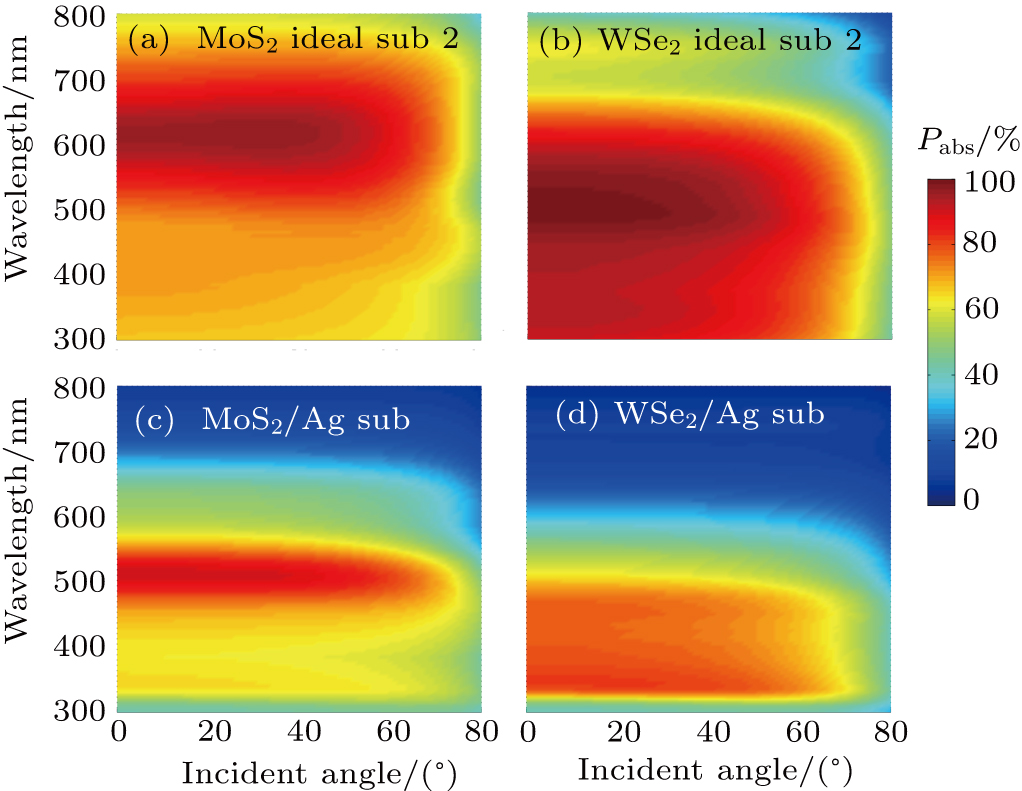 | Fig. 5. (color online) Angular response of Pabs of MoS2 and WSe2 ultrathin film with d = 9 nm on (a) and (b) Ideal sub 2 and (c) and (d) Ag substrates. |
Figure
Figure
We have presented a comprehensive study on the ultrathin-film interference effect of the system, which is composed of strongly absorbing dielectric and back metal reflector, from the underlying physics, photonic manipulation, optical performance optimization, and also the photoconversion application. The transfer-matrix treatment, impedance matching condition, and the antireflection effect are used/discussed in detail. The various geometry and material options of the absorbing dielectric and substrate are considered through a comparable study of the system optical performance. It is found that the phase matching of antireflection is necessary but not a sufficient condition for ultrahigh absorption because the admittance matching is also an inevitable requirement. Particular attention is also paid to the incorporating of the 2D materials into this ultrathin-film system, which shows very good optical absorption in a large range of the incident angle. Finally, we construct an ultrathin MoS2/WSe2 heterojunction system for photovoltaic application. Under an AM1.5 solar illumination, the short-circuit current density, open-circuit voltage, and light-conversion efficiency of the proposed heterojunction on Ag (SiO2) sub are 20 (7.0) mA/cm2, 0.61 (0.59) V, and 9.5% (3.2%), respectively. Compared with the conventional system with dielectric substrate, the dielectric/metal setup shows the photocurrent density and PCE to be enhanced by ∼ 200%, thus promoting the practical application of TMDLM in photoelectric conversion.
| [1] | |
| [2] | |
| [3] | |
| [4] | |
| [5] | |
| [6] | |
| [7] | |
| [8] | |
| [9] | |
| [10] | |
| [11] | |
| [12] | |
| [13] | |
| [14] | |
| [15] | |
| [16] | |
| [17] | |
| [18] | |
| [19] | |
| [20] | |
| [21] | |
| [22] | |
| [23] | |
| [24] | |
| [25] | |
| [26] | |
| [27] | |
| [28] | |
| [29] | |
| [30] | |
| [31] | |
| [32] | |
| [33] | |
| [34] | |
| [35] | |
| [36] | |
| [37] | |
| [38] | |
| [39] | |
| [40] | |
| [41] |


